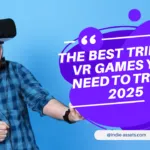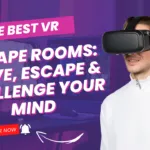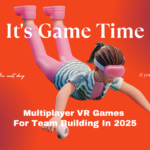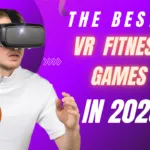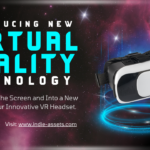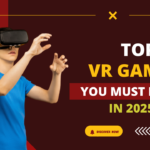Table of Contents
Intoduction For Virtual Reality VR
Virtual Reality (VR) has come a long way from its science fiction origins. Today, VR is a transformative technology, reshaping not just entertainment but industries across the board. With advancements like standalone headsets such as Meta Quest 3 and PlayStation VR2, VR is no longer just a novelty; it’s a tool for innovation. Whether you’re gaming, learning, collaborating remotely, or healing, VR is enhancing how we engage with the world around us. In this guide, we’ll delve into why VR matters, its future potential, and how you can start using it today.
Why Virtual Reality ?
At its core, Virtual Reality creates presence the feeling of being physically inside a digital world. Unlike traditional 2D screens, VR surrounds users with 360° environments, allowing for experiences that are immersive, interactive, and often transformative.
- Immersive: VR allows users to step inside their favorite games, training simulations, and even virtual meetings, offering a deeply engaging experience. Imagine standing on the edge of a cliff in a mountain climbing simulation or feeling the tension of a life-or-death moment in a survival game.
- Interactive: Through hand-tracking, gesture controls, or the use of physical controllers, VR allows you to manipulate digital objects as if they were real. This makes tasks like cooking, solving puzzles, or crafting a piece of art in VR feel remarkably intuitive.
- Empathetic: VR can place you in situations or perspectives unlike your own. Whether you’re walking in someone else’s shoes or understanding what it’s like to live with a disability, VR fosters empathy and helps users connect with the experiences of others in powerful, emotional ways.
Key Drivers of VR Adoption
1. Gaming :
Gaming has always been the primary driver of VR technology. With titles like Half-Life: Alyx and Beat Saber, VR has redefined interactive entertainment. The immersive worlds and first-person experiences offered by VR are simply unparalleled, taking gaming to a new level of realism.
2. Training & Education :
From piloting jets to performing surgery, VR enables hyper-realistic training simulations. Medical students, pilots, and engineers can practice complex tasks in a controlled, risk-free environment. Whether you’re learning a new language or training for a high-risk job, VR is revolutionizing education.
3. Remote Collaboration :
With platforms like Meta Horizon Workrooms, global teams can meet in shared 3D spaces, reducing the need for in-person meetings and fostering collaboration no matter where individuals are located. The ability to engage in virtual boardrooms and work on projects together in real-time is rapidly changing how we approach remote work.
4. Mental Health :
VR therapy has proven to be a groundbreaking approach for treating mental health issues. It’s already being used to help people with PTSD, anxiety, and phobias by exposing them to controlled, virtual environments where they can face their fears in a safe, gradual manner. Additionally, VR offers an immersive distraction, helping patients manage chronic pain during medical procedures.
The Future of VR: 5 Trends to Watch
As VR continues to evolve, several exciting trends are shaping its future:
1. Standalone Headsets
Devices like Meta Quest 3 and Pico 5 are changing the VR landscape by eliminating the need for powerful PCs or consoles. These wireless, standalone headsets allow users to enjoy high-quality VR without being tethered to a machine. By 2030, it’s predicted that standalone headsets will dominate the consumer market, providing an accessible entry point for VR enthusiasts.
2. Mixed Reality (MR)
Blending Virtual Reality (VR) with Augmented Reality (AR), mixed reality (MR) headsets such as the Apple Vision Pro are becoming more common. These devices allow users to overlay digital objects onto the real world, offering an experience that’s a hybrid of VR and AR. Architects, for example, can visualize blueprints on construction sites, creating a seamless blend of the virtual and physical worlds.
3. Haptic Feedback & Full-Body Tracking
VR’s potential for full sensory immersion is rapidly increasing. Haptic gloves and suits like Meta Quest Touch Pro or the Teslasuit simulate touch, temperature, and motion. The future of VR lies in the ability to feel textures, impacts, and even temperature changes, making the virtual world more tangible than ever.
4. AI-Powered Worlds
Generative AI is poised to create dynamic, ever-changing VR environments. Imagine a game where NPCs (non-playable characters) learn from your behavior, altering their interactions based on your actions. These AI-driven experiences will make virtual worlds feel alive, evolving in real-time in response to your decisions.
5. Neural Interfaces
While still in its infancy, companies like Neuralink are developing neural interfaces that could eventually bypass controllers entirely. By using brain signals to navigate VR, users could control their virtual environments with their minds, making VR even more intuitive. However, this technology raises ethical debates and is still far from mainstream.
How VR Is Used Today: Beyond Gaming
While gaming is the flagship use of VR, its applications have expanded into a variety of industries:
1. Education & Training
- Medical Students: In VR, aspiring surgeons can practice surgeries in Osso VR, a platform that simulates realistic medical procedures, complete with haptic feedback to recreate the feeling of performing actual surgeries.
- Corporate Training: Companies like Walmart have turned to VR to simulate busy environments (e.g., Black Friday crowds), helping employees train for high-pressure situations before they occur.
2. Healthcare & Therapy
- PTSD Treatment: Programs like Bravemind allow veterans to relive traumatic events in a controlled VR environment, helping them confront their trauma gradually and safely.
- Pain Management: VR has been shown to reduce perceived pain by up to 40%, providing a non-invasive option to distract patients during medical procedures.
3. Remote Work & Collaboration
- Spatial: Teams can brainstorm in 3D whiteboard rooms, working together in a virtual environment that feels more interactive and engaging than traditional video calls.
- VR Conferencing: Platforms like Meta Horizon Workrooms offer customizable avatars, allowing users to attend meetings and collaborate in real-time as virtual representations of themselves.
4. Real Estate & Architecture
- Virtual Walkthroughs: Clients can now explore unbuilt homes or commercial spaces in VR, providing a more immersive experience compared to traditional 2D renderings.
- Tools: Companies like Matterport have created 3D scanning technologies that digitize real-world properties, enabling virtual tours that can be viewed remotely.
5. Entertainment & Social VR
- Concerts: Attend live shows in virtual worlds like Fortnite or WaveXR, where you can enjoy performances as a virtual avatar, even interacting with other concertgoers in real-time.
- Social Worlds: Platforms like VRChat and Rec Room let you interact with people in digital environments, whether you’re hanging out with friends or creating your own virtual worlds.
Getting Started with VR
If you’re ready to explore VR for yourself, here’s how to get started:
Choose a Headset:
- Budget: Meta Quest 3 ($499, wireless, no PC required)
- Premium: PlayStation VR2 ($549, 4K HDR, haptic feedback)
- PC Enthusiast: Valve Index 2 ($999, best-in-class tracking)
Explore Apps & Games:
- Fitness: Supernatural VR (guided workouts)
- Productivity: Immersed (multi-screen workspace)
- Creativity: Tilt Brush (3D painting)
Develop for VR:
- Engines: Unity and Unreal Engine offer VR toolkits that make it easier to build immersive experiences.
- Assets: Utilize royalty-free 3D models and sound packs to speed up development.
Challenges & Considerations
While VR is evolving rapidly, there are some challenges to consider:
1. Motion Sickness:
Motion sickness can occur in some VR experiences, especially if you’re moving in the virtual world while stationary in real life. Start with stationary experiences like Moss and use comfort settings to minimize discomfort.
2. Cost:
High-end VR setups require expensive hardware, including a powerful PC. However, standalone headsets like the Meta Quest 3 provide a more affordable alternative.
3. Content Gaps:
While gaming has flourished in VR, enterprise and niche applications are still catching up. The development of specialized content in fields like education, therapy, and business is essential for broader VR adoption.
The Road Ahead
By 2030, VR could become as ubiquitous as smartphones. Imagine:
- Virtual Tourism: Visit landmarks like the Pyramids or Mars from your living room.
- Education Revolution: Students could dissect virtual frogs or walk through ancient Rome.
- Neurodivergent Support: VR environments could be customized to support individuals with sensory sensitivities.
Why Indie Developers Should Care
For indie creators, VR presents a huge opportunity:
- Low Competition: Niche markets (such as therapy, education, or specific gaming genres) are still emerging, offering space for fresh ideas and innovation.
- Asset Stores: Speed up development with pre-built 3D models, sound packs, and other assets that save time and resources.
- Crowdfunding: Platforms like Kickstarter are enabling indie VR developers to bring their ideas to life, opening the door for innovative new projects.
Final Thoughts
Virtual Reality is not just about escaping reality it’s about enhancing it. Whether you’re a gamer, developer, educator, or entrepreneur, VR offers endless possibilities to improve how we interact with the digital world. The future is bright for VR, and now is the perfect time to start exploring it.
What’s your VR dream? Share your thoughts in the comments! 🕶️🚀

